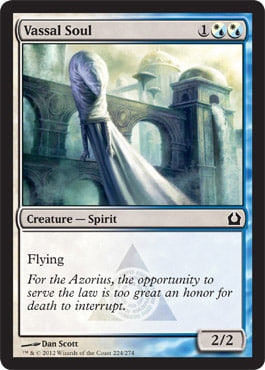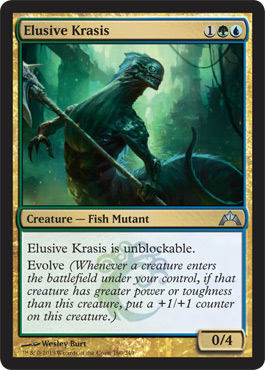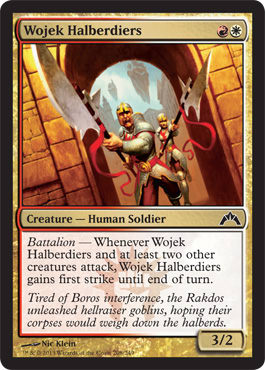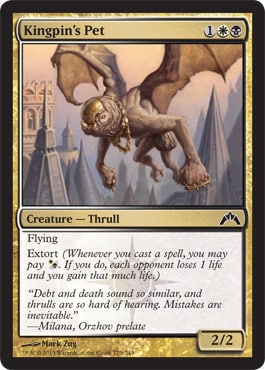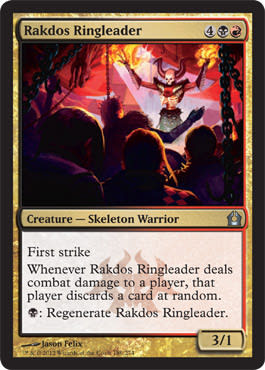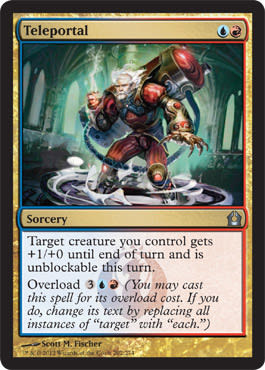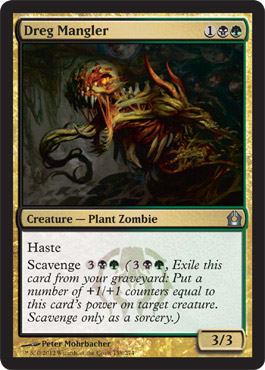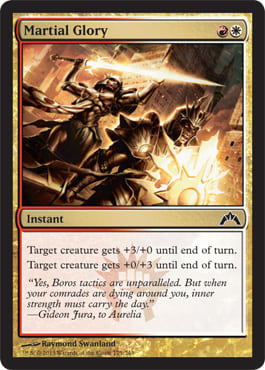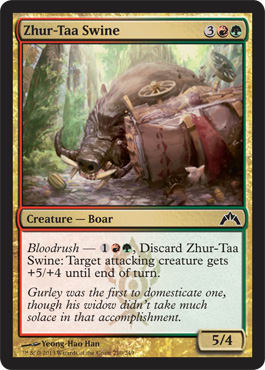We may be drafting either all Return to Ravnica or all Gatecrash now, but with the imminent arrival of Dragon’s Maze, Booster Draft will soon receive a complete makeover. The Draft format for Pro Tour: Dragon’s Maze will be one pack of Dragon’s Maze, one pack of Gatecrash, and one pack of Return to Ravnica—in that order. This will have a dramatic effect on how we draft.
Drafting three packs of Gatecrash is resulting in an incredibly fast-paced environment, with games ending on earlier turns than almost any recent Draft format. While it’s hard to say too much for certain before Dragon’s Maze comes out, three-set Draft should slow things down considerably and open the door for more control. Drafting aggressive decks benefits from consistency, and this is increased by drafting three packs of the same set.
Aggressive decks are typically loaded with cheap creatures. While expensive creatures are typically quite powerful on their own, cheap creatures usually need make use of synergy to maximize their power. For example, if you draft a Boros deck with three packs of Gatecrash, you can ramp up the power of your deck by playing with a lot of 1-drops and haste creatures to get battalion going as soon as possible. With this in mind, I’ll prioritize 1-drops and haste creatures early in the Draft, knowing that I will end up with several battalion creatures by the time I finish. With only one pack of Gatecrash, I cannot make the same assumption. I will also prioritize red creatures when drafting all-Gatecrash Boros since I’m usually sure to pick up multiple Foundry Street Denizens, but this plan also falls apart in three-set Draft. Drafting three packs of the same set helps aggressive decks acquire the tight synergy that can make them superior to control decks that feature a higher curve and a more powerful late game. Drafting three different sets with different mechanics and different commons opens things up for control decks to gain the upper hand.
It’s no surprise that most aggressive Draft decks are only one or two colors and that decks with three or more colors are usually more controlling. Full RTR-block Draft will be very conducive to drafting more than two colors. This is in part because gold cards are typically more powerful than single-color cards of the same converted mana costs. If you’re only playing two colors, there will be at least one pack in which you won’t be able to draft any gold cards for your deck. Not only will this lower the potential power level of your deck, but it will mean you have considerably fewer cards to choose from when drafting.
Let’s say you’re drafting Boros for example. When you’re picking from Gatecrash, you’ll have red cards, white cards and R/W gold cards to choose from for your deck. When you’re drafting the Return to Ravnica pack, you’ll just have red and white cards to choose from. If you’re not in an excellent seat for Boros, you could be in trouble, especially given the number of people who will be playing more than two colors and cherry-picking the cards you really want. If you’re playing R/W/U, however, your options become incredibly expanded. In Gatecrash, you’ll still have red, white and R/W gold cards to choose from, but you’ll also have blue cards as an option. Instead of Return to Ravnica being restrictive for you as it would be if you were just Boros, you suddenly can choose from a cornucopia of options: red, white, blue, U/R and W/U cards.
So, drafting three colors in full-block Draft should be a good idea, but what three colors? For that, we need to determine which trios of guilds have the best synergies and have the best tools for a three-colored control deck.
R/W/U – Boros, Azorius, Izzet
Anyone who’s drafted these three colors in triple-RTR Draft can tell you what an incredible late game it has—it just sometimes fell too far behind in the early game. Adding Boros helps shore up the early game while also giving you more control options such as Basilica Guards, Mugging, Pit Fight, and Smite in Gatecrash. Two of the most powerful elements for a control deck are removal and evasion. This trio provides you with these elements in heaping portions. R/W/U will typically be best as base-W/U with red as the support color. There will be an emphasis on spells, flyers, and creature control. If you have a good draw, you can even go aggro with battalion and detain helping you tempo your opponent out.
W/U/B – Azorius, Dimir, Orzhov
This trio combines the most popular control guilds from each of the two existing sets: Azorius and Orzhov. Having access to Dimir is almost just a nice little bonus. Detain also has excellent synergy with cipher.
W/B/R – Orzhov, Rakdos, Boros
This powerful trio can slide easily between control and aggro. If you’re base-red, Rakdos and Boros can give you a hyper-aggressive early game with battalion and unleash, and then, you can use extort to finish off pesky control decks that think they’ve stabilized. Alternately, extort works nicely in a control deck, which in these colors should have a ton of removal.
U/B/R – Dimir, Rakdos, Izzet
Playing a blue deck with red and black for removal is a sure recipe for a strong control deck. Encoding an unleashed creature and then backing it up with removal seems as though it could also be a good plan—especially since both abilities are all about swinging and not staying back to block. Dimir and Izzet can do a nice job of providing Rakdos with the late game that it’s sometimes missing.
B/R/G – Rakdos, Gruul, Golgari
While green doesn’t provide you with much in the way of evasion or removal for your control deck, it can give you a bit of color smoothing, which can be a big deal when you’re playing three colors. This trio gives you the ability to play sustained aggression, which might be the best way to play aggro with three-pack Draft. Rakdos and Gruul give you strong early aggression, while bloodrush and scavenge can give your cheap creatures the ability to power through a control deck’s bigger creatures in the late game. Another advantage of playing green is that you can just draft some really fat creatures to help you compete with other control decks in the late game.
R/G/W – Gruul, Selesnya, Boros
If you’re going to draft a trio that’s all about aggro, this might be just what you’re looking for. These are easily three of the four best aggro guilds (Rakdos being the other). While populate becomes much weaker in three-set Draft, Selesnya can be drafted quite well without it. The combination of battalion, bloodrush, and Selesnya pump spells ensures your ability to dominate the red zone.
G/W/U – Selesnya, Azorius, Simic
This trio also relies heavily on aggression. Selesnya has some of the biggest early-game creatures in the block, which goes nicely with evolve. If your opponent actually does play a creature big enough to stem the tide, pump, bounce, or detain should take care of it.
U/R/G – Izzet, Gruul, Simic
This trio has almost as much early beefiness as G/W/U—plus, it also has burn and bloodrush. In addition, Izzet can help give this aggressive trio some much needed late game.
G/U/B – Simic, Dimir, Golgari
This trio can use the combination of evolve and scavenge to build horrifying monstrosities. In the process, you can create a badass target for cipher. Unfortunately, this trio doesn’t have either a truly elite early game or late game, and it doesn’t have enough removal to compensate.
B/G/W – Golgari, Selesnya, Orzhov
Selesnya gives you a decent early game, and you can hope the combination of extort, scavenge, and pump will give you enough late game. This trio is hurt by having such sparse high-quality removal and evasion options.
While it’s good to start planning ahead, much of this evaluation could be stood on its head depending on what happens with Dragon’s Maze. Since DGM will feature all ten guilds, it should be loaded with gold cards, and drafting three colors seems as though it must be the way to go. Given that almost every pack will have a dual land of some sort, even the mana should be quite doable. Now you’ll just need to figure out which trios will work best for you.














